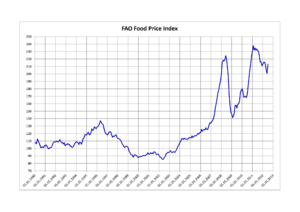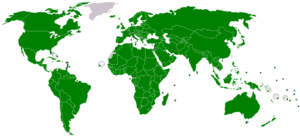Food and Agriculture Organization facts for kids
Quick facts for kids  Food and Agriculture Organization (FAO) |
|
|---|---|
| Org type | United Nations specialized agency |
| Status | Active |
| Headquarters | Rome, Italy |
The Food and Agriculture Organization of the United Nations (FAO) is a specialized agency of the United Nations that leads international efforts to defeat hunger and improve nutrition and food security. Its Latin motto, fiat panis, translates to "let there be bread". It was founded on 16 October 1945.
The FAO comprises 195 members, including 194 countries and the European Union. Its headquarters is in Rome, Italy, and it maintains regional and field offices worldwide, operating in over 130 countries. It helps governments and development agencies coordinate their activities to improve and develop agriculture, forestry, fisheries, and land and water resources. It also conducts research, provides technical assistance to projects, operates educational and training programs, and collects agricultural output, production, and development data.
The FAO is governed by a biennial conference representing each member country and the European Union, which elects a 49-member executive council. The Director-General, as of 2019 Qu Dongyu of China, serves as the chief administrative officer. Various committees govern matters such as finance, programs, agriculture, and fisheries.
| 100 lire (FAO's celebration.) | |
|---|---|
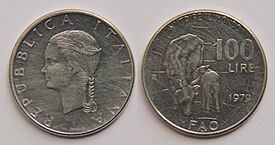 |
|
| Obverse: Young woman with braid facing left. Surrounded by Repubblica Italiana [Italian Republic]. | Reverse: Cow nursing calf, face value & date. FAO at bottom and Nutrire il Mondo [Feed the world] at top. |
| Coined minted by Italy in 1970s to celebrate and promote Food and Agriculture Organization. | |
Contents
- History
- Structure and finance
- Offices
- Priority work areas
- Programmes and achievements
- Codex Alimentarius
- Agriculture
- International Plant Protection Convention
- Plant Treaty (ITPGRFA)
- Alliance Against Hunger and Malnutrition
- Integrated pest management
- Trans-boundary pests and diseases
- Global Partnership Initiative for Plant Breeding Capacity Building
- Investment in agriculture
- Globally Important Agricultural Heritage Systems (GIAHS)
- Commission on Genetic Resources for Food and Agriculture (CGRFA)
- Animal Genetic Resources
- Forestry
- Fisheries
- Statistics
- Membership
- FAO renewal
- See also
History
The idea of an international organization for food and agriculture emerged in the late 19th and early 20th century, advanced primarily by Polish-born American agriculturalist and activist David Lubin. In May–June 1905, an international conference was held in Rome, Italy, which led to the creation of the International Institute of Agriculture (IIA) by the King of Italy, Victor Emmanuel III.
The IIA was the first intergovernmental organization to deal with the problems and challenges of agriculture on a global scale. It worked primarily to collect, compile, and publish data on agriculture, ranging from output statistics to a catalog of crop diseases. Among its achievements was the publication of the first agricultural census in 1930.
World War II effectively ended the IIA. During the war, in 1943, United States President Franklin D. Roosevelt called a League of Nations Conference on Food and Agriculture, which brought representatives from forty-four governments to The Omni Homestead Resort in Hot Springs, Virginia, from 18 May to 3 June to attend the Hot Springs Conference. The main impetus for the conference was the British-born Australian economist Frank L. McDougall, who since 1935 had advocated for an international forum to address hunger and malnutrition.
The Conference ended with a commitment to establish a permanent organization for food and agriculture, which was achieved on 16 October 1945 in Quebec City, Canada, following the Constitution of the Food and Agriculture Organization. The first session of the FAO Conference began the same day in the Château Frontenac in Quebec City and ended on 1 November 1945. This was led by Sir John Boyd Orr where his work on ending world hunger and creation of FAO resulted in him winning the Nobel Peace Prize in 1949.
After the war, the IIA was officially dissolved by resolution of its Permanent Committee on 27 February 1948. Its functions, facilities, and mandate were then transferred to the newly established FAO, which maintained its headquarters in Rome.
The FAO's initial functions supported agricultural and nutrition research and provided technical assistance to member countries to boost production in agriculture, fishery, and forestry. Beginning in the 1960s, it focused on efforts to develop high-yield strains of grain, eliminate protein deficiency, promote rural employment, and increase agricultural exports. The FAO recognized the decrease of these resources as an urgent problem in 1961 and created a joint collaboration with the International Biological Program (IBP) in 1967. To that end, it joined the UN General Assembly in creating the UN World Food Programme, the largest humanitarian organization addressing hunger and promoting food security.
The FAO launched what would become the FAO Money and Medals Programme (MMP) in 1968. FAO issued collector art medals in various series to bring attention to FAO's goals and missions. This program was responsible for over a hundred medal designs issued to the collecting public. A thirtieth anniversary medal of the MMP was issued in 1998.
In 1974, in response to famine in Africa, the FAO convened the first World Food Summit to address widespread hunger, malnutrition, and food insecurity. The meeting resulted in a proclamation that "every man, woman, and child has the inalienable right to be free from hunger and malnutrition to develop their physical and mental faculties" and a global commitment to eradicate these issues within a decade. A subsequent summit in 1996 addressed the shortcomings in achieving this goal while establishing a strategic plan for eliminating hunger and malnutrition into the 21st century.
Every year, FAO publishes a number of major 'State of the World' reports related to food, agriculture, forestry, fisheries and natural resources.
Structure and finance
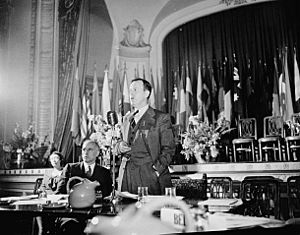
In 1951, the FAO's headquarters were moved from Washington, D.C., United States, to Rome, Italy. The agency is directed by the Conference of Member Nations, which meets every two years to review the work carried out by the organization and to Work and Budget for the next two-year period. The Conference elects a council of 49 member states (serve three-year rotating terms) that acts as an interim governing body, and the Director-General, who heads the agency.
The FAO is composed of eight departments: Agriculture and Consumer Protection, Climate, Biodiversity, Land and Water Department, Economic and Social Development, Fisheries and Aquaculture, Forestry, Corporate Services and Technical Cooperation and Programme Management.
Beginning in 1994, the FAO underwent the most significant restructuring since its founding, to decentralize operations, streamline procedures and reduce costs. As a result, savings of about US$50 million, €43 million a year were realized.
Budget
The FAO's Regular Programme budget is funded by its members, through contributions set at the FAO Conference. This budget covers core technical work, cooperation and partnerships including the Technical Cooperation Programme, knowledge exchange, policy and advocacy, direction and administration, governance and security.
The total FAO Budget planned for 2018–2019 is US$1,005.6 million. The voluntary contributions provided by members and other partners support mechanical and emergency (including rehabilitation) assistance to governments for clearly defined purposes linked to the results framework, as well as direct support to FAO's core work. The voluntary contributions are expected to reach approximately US$1.6 billion in 2016–2017.
This overall budget covers core technical work, cooperation and partnerships, leading to Food and Agriculture Outcomes at 71 percent; Core Functions at 11 percent; the Country Office Network – 5 percent; Capital and Security Expenditure – 2 percent; Administration – 6 percent; and Technical and Cooperation Program – 5 percent.
Directors-General
- John Boyd Orr, October 1945 – April 1948
- Norris E. Dodd, April 1948 – December 1953
- Philip V. Cardon, January 1954 – April 1956
- Herbert Broadley, (acting) April 1956 – November 1956
- Binay Ranjan Sen, November 1956 – December 1967
- Addeke Hendrik Boerma, January 1968 – December 1975
- Edouard Saouma, January 1976 – December 1993
- Jacques Diouf, January 1994 – December 2011
- José Graziano da Silva, January 2012 – July 2019
- Qu Dongyu, August 2019 – present
Deputy Directors-General
- William Nobel Clark: 1948
- Sir Herbert Broadley: 1948–1958
- Friedrich Traugott Wahlen: 1958–1959
- Norman C. Wright: 1959–1963
- Oris V. Wells: 1963–1971
- Roy I. Jackson: 1971–1978
- Ralph W. Phillips: 1978–1981
- Edward M. West: 1981–1985
- Declan J. Walton: 1986–1987
- Howard Hjort: 1992–1997
- Vikram J. Shah (ad personam): 1992–1995
- David A. Harcharik: 1998–2007
- James G. Butler: 2008–2010
- He Changchui (Operations): 2009–2011
- Ann Tutwiler (Knowledge): 2011–2012
- Manoj Juneja (Operations): 2011–2012
- Dan Gustafson (Programmes): 2012–2020
- Maria Helena Semedo: 2013–present
- Laurent Thomas: 2017–2023
- Beth Bechdol: 2020–present
- Maurizio Martina: 2023-present
Offices
FAO Headquarters
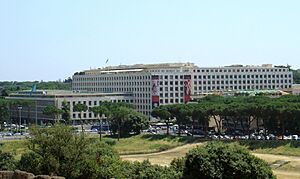
The world headquarters is located in Rome, in the former seat of the Department of Italian East Africa. One of the most notable features of the building was the Axum Obelisk which stood in front of the agency seat, although just outside the territory allocated to the FAO by the Italian Government. It was taken from Ethiopia by Benito Mussolini's troops in 1937 as war booty and returned on 18 April 2005.
Regional Offices
- Regional Office for Africa, in Accra, Ghana
- Regional Office for Asia and the Pacific, in Bangkok, Thailand
- Regional Office for Europe and Central Asia, in Budapest, Hungary
- Regional Office for Latin America and the Caribbean, in Santiago de Chile, Chile
- Regional Office for the Near East, in Cairo, Egypt
Sub-regional Offices
- Sub-regional Office for Central Africa (SFC), in Libreville, Gabon
- Sub-regional Office for Central Asia, in Ankara, Turkey
- Sub-regional Office for Eastern Africa (SFE), in Addis Ababa, Ethiopia
- Sub-regional Office for Mesoamerica (SLM), in Panama City, Panama
- Sub-regional Office for North Africa, in Tunis, Tunisia
- Sub-regional Office for Southern Africa and East Africa, in Harare, Zimbabwe
- Sub-regional Office for the Caribbean, in Bridgetown, Barbados
- Sub-regional Office for the Gulf Cooperation Council States and Yemen, in Abu Dhabi, United Arab Emirates
- Sub-regional Office for the Pacific Islands, in Apia, Samoa
Liaison Offices
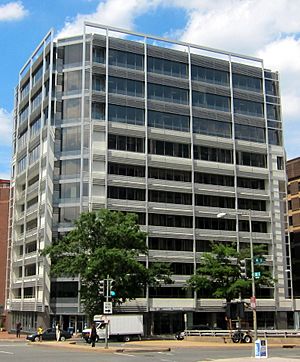
- Liaison Office for North America, in Washington, D.C., United States
- Liaison Office with Japan, in Yokohama
- Liaison Office with the European Union and Belgium, in Brussels
- Liaison Office with the Russian Federation, in Moscow
- Liaison Office with the United Nations, in Geneva, Switzerland
- Liaison Office with the United Nations, in New York City, United States
Partnership and Liaison Offices
Partnership and Liaison Offices provide for stronger country participation in the FAO's work and programmes at national, sub-regional, regional, and inter-regional levels, and enhanced cooperation through unilateral trust fund projects and South–South cooperation.
- Azerbaijan
- Cameroon
- Côte d'Ivoire (Ivory Coast)
- Equatorial Guinea
- Kazakhstan
- Mexico
- Republic of Korea (South Korea)
Priority work areas
FAO has outlined the following priorities in its fight against hunger.
- Help eliminate hunger, food insecurity, and malnutrition – contribute to eradicating hunger by facilitating policies and political commitments to support food security and make sure that up-to-date information about hunger and nutrition challenges and solutions is available and accessible.
- Make agriculture, forestry, and fisheries more productive and sustainable – promote evidence-based policies and practices to support highly productive agricultural sectors (crops, livestock, forestry, and fisheries) while ensuring that the natural resource base does not suffer in the process.
- Reduce rural poverty by helping the rural poor gain access to the resources and services they need, including rural employment and social protection.
- Enable inclusive and efficient agricultural and food systems – helping to build safe and efficient food systems that support smallholder agriculture and reduce poverty and hunger in rural areas.
- Increase the resilience of livelihoods to threats and crises – helping countries to prepare for natural and human-caused disasters by reducing their risk and enhancing the resilience of their food and agricultural systems.
Two fundamental areas of work – gender and governance – are fully integrated in the above strategic objective action plans.
Programmes and achievements
Codex Alimentarius
FAO and the World Health Organization created the Codex Alimentarius Commission in 1961 to develop food standards, guidelines, and texts such as codes of practice under the Joint FAO/WHO Food Standards Programme. The programme's main aims are protecting consumer health, ensuring fair trade, and promoting co-ordination of all food standards work undertaken by intergovernmental and non-governmental organizations.
World Food Summit
In 1996, FAO organized the World Food Summit, attended by 112 Heads or Deputy Heads of State and Government. The Summit concluded with the signing of the Rome Declaration, which established the goal of halving the number of people who suffer from hunger by 2015. At the same time, 1,200 civil society organizations (CSOs) from 80 countries participated in an NGO forum. The forum was critical of the growing industrialization of agriculture and called upon governments – and FAO – to do more to protect the 'Right to Food' for the poor.
TeleFood
In 1997, FAO launched TeleFood, a campaign of concerts, sporting events, and other activities to harness the power of media, celebrities, and concerned citizens to help fight hunger. Since its start, the campaign has generated close to US$28 million, €15 million in donations. Money raised through TeleFood pays for small, sustainable projects that help small-scale farmers produce more food for their families and communities.
The projects provide tangible resources, such as fishing equipment, seeds, and agricultural implements. They vary enormously, from helping families raise pigs in Venezuela through creating school gardens in Cape Verde and Mauritania or providing school lunches in Uganda and teaching children to grow food to raising fish in a leper community in India.
FAO Goodwill Ambassadors
The FAO Goodwill Ambassadors Programme was initiated in 1999. It was created to increase public awareness and disseminate information about issues related to food security and hunger in the world.
Right to Food Guidelines
In 2004 the Right to Food Guidelines were adopted which offer guidance to states on how to implement their obligations on the right to food.
FAO–EU partnership
In May 2009, FAO and the European Union signed an initial aid package worth €125 million to support small farmers in countries hit hard by rising food prices. The aid package falls under the EU's €1 billion Food Facility, set up with the UN Secretary-General's High-Level Task Force on the Global Food Crisis and FAO to focus on programmes that will have a quick but lasting impact on food security. FAO is receiving around €200 million for work in 25 countries, of which €15.4 million goes to Zimbabwe.
Food security programmes
The Special Programme for Food Security is FAO's flagship initiative for reaching the goal of halving the number of hungry in the world by 2015 (currently estimated at close to 1 billion people) as part of its commitment to the Millennium Development Goals. Through projects in over 100 countries worldwide, the programme promotes effective, tangible solutions to eliminating hunger, undernourishment, and poverty. Currently, 102 countries are engaged in the programme, and of these, approximately 30 have begun shifting from pilot to national programmes. To maximize the impact of its work, FAO strongly promotes national ownership and local empowerment in the countries in which it operates.
Online campaign against hunger
The 1billionhungry project became the EndingHunger campaign in April 2011. Spearheaded by FAO in partnership with other UN agencies and private nonprofit groups, the EndingHunger movement pushes the boundaries of conventional public advocacy. It builds on the success in 2010 of The 1billonhungry project and the subsequent chain of public events that led to the collection of over three million signatures on a global petition to end hunger (www.EndingHunger.org). The petition was originally presented to representatives of world governments at a ceremony in Rome on 30 November 2010.
The web and partnerships are two pivotal and dynamic aspects of EndingHunger. The campaign relies on the assistance of organizations and institutions that can facilitate the project's diffusion, by placing banners on their own websites or organizing events aimed to raise awareness of the project. In its 2011 season, the campaign expanded its multimedia content, pursued mutual visibility arrangements with partner organizations, and sharpened its focus on 14- to 25-year-olds, who were encouraged to understand their potential as a social movement to push for the end of hunger.
Moreover, the EndingHunger project is a viral communication campaign, renewing and expanding its efforts to build the movement through Facebook, Twitter and other social networks. Those who sign the petition can spread the link of the EndingHunger website to their friends, via social media or mail, in order to gain awareness and signatures for the petition. The next interim objective is to grow the EndingHunger movement's Facebook community to 1 million members. As with the petition, the more people who get involved, the more powerful the message to governments: "We are no longer willing to accept the fact that hundreds of millions live in chronic hunger." Groups and individuals can also decide on their own to organize an event about the project, simply by gathering friends, whistles, T-shirts and banners (whistles and T-shirts can be ordered, and petition sign sheets downloaded, on the endinghunger.org website) and thereby alert people about chronic hunger by using the yellow whistle.
The original 1billionhungry campaign borrowed as its slogan the line "I'm as mad as hell, and I'm not going to take this anymore!", used by Peter Finch in the 1976 film, Network. Meanwhile, the yellow whistle has been the campaign symbol from the start, from 1billionhungry to Ending Hunger. (The creative concept was provided by the McCann Erickson Italy Communication Agency.) It symbolizes the fact that we are "blowing the whistle" on the silent disaster of hunger. It is both a symbol and – at many live events taking place around the world – a physical means of expressing frustration and making some noise about the hunger situation.
Both The 1billionhungry and the EndingHunger campaigns have continued to attract UN Goodwill Ambassadors from the worlds of music and cinema, literature, sport, activism and government. Some of the well known individuals who have become involved include former Brazilian President Luiz Inácio Lula da Silva, former presidents of Chile Ricardo Lagos and Michelle Bachelet, actress Susan Sarandon, actors Jeremy Irons and Raul Bova, singers Céline Dion and Anggun, authors Isabelle Allende and Andrea Camilleri, musician Chucho Valdés and Olympic track-and-field legend Carl Lewis.
Agriculture
International Plant Protection Convention
FAO created the International Plant Protection Convention or IPPC in 1952. This international treaty organization works to prevent the international spread of pests and plant diseases in both cultivated and wild plants. Among its functions are the maintenance of lists of plant pests, tracking of pest outbreaks, and coordination of technical assistance between member nations. As of July 2018, 183 contracting parties have ratified the treaty.
Plant Treaty (ITPGRFA)
FAO is depositary of the International Treaty on Plant Genetic Resources for Food and Agriculture, also called Plant Treaty, Seed Treaty or ITPGRFA, entered into force on 29 June 2004.
Alliance Against Hunger and Malnutrition
The Alliance Against Hunger and Malnutrition (AAHM) aims to address how countries and organizations can be more effective in advocating and carrying out actions to address hunger and malnutrition. As a global partnership, AAHM creates global connections between local, regional, national and international institutions that share the goals of fighting hunger and malnutrition. The organization works to address food security by enhancing resources and knowledge sharing and strengthening hunger activities within countries and across state lines at the regional and international levels.
Following the World Food Summit, the Alliance was initially created in 2002 as the 'International Alliance Against Hunger (IAAH)' to strengthen and coordinate national efforts in the fight against hunger and malnutrition. The mission of the Alliance originates from the first and eighth UN Millennium Development Goals; reducing the number of people that suffer from hunger in half by 2015 (preceded by the "Rome Declaration" in 1996) and developing a global partnership for development. The Alliance was founded by the Rome-based food agencies – the Food and Agriculture Organization of the United Nations (FAO), UN World Food Programme (WFP), International Fund for Agricultural Development (IFAD), – and Bioversity International.
AAHM connects top-down and bottom-up anti-hunger development initiatives, linking governments, UN organizations, and NGOs together in order to increase effectiveness through unity.
Integrated pest management
During the 1990s, FAO took a leading role in the promotion of integrated pest management for rice production in Asia. Hundreds of thousands of farmers were trained using an approach known as the Farmer Field School (FFS). Like many of the programmes managed by FAO, the funds for Farmer Field Schools came from bilateral Trust Funds, with Australia, Netherlands, Norway and Switzerland acting as the leading donors. FAO's efforts in this area have drawn praise from NGOs that have otherwise criticized much of the work of the organization.
Trans-boundary pests and diseases
FAO established an Emergency Prevention System for Transboundary Animal and Plant Pests and Diseases in 1994, focusing on the control of diseases like rinderpest, foot-and-mouth disease and avian flu by helping governments coordinate their responses. One key element is the Global Rinderpest Eradication Programme, which has advanced to a stage where large tracts of Asia and Africa have now been free of the cattle disease rinderpest for an extended period of time. Meanwhile, the Desert Locust Information Service monitors the worldwide locust situation and keeps affected countries and donors informed of expected developments.
Global Partnership Initiative for Plant Breeding Capacity Building
The Global Partnership Initiative for Plant Breeding Capacity Building (GIPB) is a global partnership dedicated to increasing plant breeding capacity building. The mission of GIPB is to enhance the capacity of developing countries to improve crops for food security and sustainable development through better plant breeding and delivery systems. The ultimate goal is to ensure that a critical mass of plant breeders, leaders, managers and technicians, donors and partners are linked together through an effective global network.
Increasing capacity building for plant breeding in developing countries is critical for the achievement of meaningful results in poverty and hunger reduction and to reverse the current worrisome trends. Plant breeding is a well recognized science capable of widening the genetic and adaptability base of cropping systems, by combining conventional selection techniques and modern technologies. It is essential to face and prevent the recurrence of crises such as that of the soaring food prices and to respond to the increasing demands for crop based sources of energy.
Investment in agriculture
FAO's technical cooperation department hosts an Investment Centre that promotes greater investment in agriculture and rural development by helping developing countries identify and formulate sustainable agricultural policies, programmes and projects. It mobilizes funding from multilateral institutions such as the World Bank, regional development banks and international funds as well as FAO resources.
Globally Important Agricultural Heritage Systems (GIAHS)
The Globally Important Agricultural Heritage Systems (GIAHS) Partnership Initiative was conceptualized and presented by Parviz Koohafkan the Task Manager of Chapter 10 of Agenda 21 in Food and Agricultural Organization of United Nations, FAO in 2002 during World Summit on Sustainable Development in Johannesburg, South Africa. This UN Partnership Initiative aims to identify, support and safeguard Globally Important Agricultural Heritage Systems and their livelihoods, agricultural and associated biodiversity, landscapes, knowledge systems and cultures around the world. The GIAHS Partnership recognizes the crucial importance of the well-being of family farming communities in an integrated approach while directing activities towards sustainable agriculture and rural development.
Commission on Genetic Resources for Food and Agriculture (CGRFA)
The Commission on Genetic Resources for Food and Agriculture was established in 1983 and provides a unique intergovernmental forum that specifically addresses biological diversity for food and agriculture. Its main objective is to ensure the sustainable use and conservation of biodiversity for food and agriculture and the fair and equitable sharing of benefits derived from its use, for present and future generations.http://www.fao.org/cgrfa/en/
Animal Genetic Resources
FAO has a unit focused on Animal Genetic Resources, which are defined as "those animal species that are used, or may be used, for the production of food and agriculture, and the populations within each of them. These populations within each species can be classified as wild and feral populations, land-races and primary populations, standardized breeds, selected lines, varieties, strains and any conserved genetic material; all of which are currently categorized as Breeds." FAO assists countries in implementation of the Global Plan of Action for Animal Genetic Resources. FAO supports a variety of ex situ and in situ conservation strategies including cryoconservation of animal genetic resources.
Forestry
One of FAO's strategic goals is the sustainable management of the world's forests. The Forestry Division works to balance social and environmental considerations with the economic needs of rural populations living in forest areas. FAO serves as a neutral forum for policy dialogue, as a reliable source of information on forests and trees and as a provider of expert technical assistance and advice to help countries develop and implement effective national forest programmes.
FAO is both a global clearinghouse for information on forests and forest resources and a facilitator that helps building countries' local capacity to provide their own national forest data. In collaboration with member countries, FAO carries out periodic global assessments of forest resources, which are made available through reports, publications and the FAO's Web site. The Global Forest Resources Assessment provides comprehensive reporting on forests worldwide every five years. FRA 2020 is the most recent global assessment. The results, data and analyses are available online in different formats, including key findings, main report and country reports.
Every two years, FAO publishes the State of the World's Forests, a major report covering current and emerging issues facing the forestry sector.
Since 1947, FAO has published the FAO Yearbook of Forest Products, a compilation of statistical data on basic forest products from over 100 countries and territories of the world. It contains data on the volume of production; and the volume, value and direction of trade in forest products.
Unasylva, FAO's peer-reviewed journal on forestry, has been published in English, French and Spanish on a regular basis since 1947, the longest-running multilingual forestry journal in the world.
The FAO is an official sponsor of International Day of Forests, on 21 March each year, as proclaimed by the United Nations General Assembly on 28 November 2012.
Every six years since 1926, FAO and a host member state hold the World Forestry Congress. It is a forum for the sharing of knowledge and experience regarding the conservation, management and use of the world's forests, and covers such issues as international dialogue, socio-economic and institutional aspects, and forest policies.
The Forestry Department is also organized geographically in several groups covering the whole world's forest ecosystems. One of them is the Silva Mediterranean work-group, covering the pan-Mediterranean region.
Tree Cities of the World
At the World Forum on Urban Forests in October 2018, the FAO and the Arbor Day Foundation jointly launched the Tree Cities of the World programme. The aim of this programme is to celebrate and recognize cities and towns of all sizes throughout the world which have shown a commitment to maintaining their urban forests. From the end of 2019, any municipality which has responsibility for its trees was able to apply to join Tree Cities of the World. On 4 February 2020, 59 cities were announced as having achieved the designation of Tree City of the World. There were 27 in the United States, with the rest scattered across the world.
Fisheries
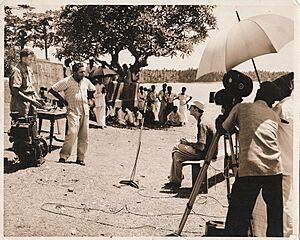
The FAO Fisheries and Aquaculture Department is defined through its vision and mission statements:
- Vision: A world in which responsible and sustainable use of fisheries and aquaculture resources makes an appreciable contribution to human well-being, food security and poverty alleviation.
- Mission: To strengthen global governance and the managerial and technical capacities of members and to lead consensus-building towards improved conservation and utilization of aquatic resources.
The work of the Fisheries and Aquaculture Department centers on the "Sustainable management and use of fisheries and aquaculture resource," embracing normative as well as operational activities, whether implemented from headquarters or from the field.
Statistics
ESSG is an acronym for the Global Statistics Service, the major "section" of the United Nations' Food and Agriculture Organization - Statistics Division. It is responsible for updating and disseminating the FAOSTAT report. This offers free and easy access to data for 245 countries and 35 regional areas from 1961 through the most recent year available. Enhanced features include browsing and analysis of data, an advanced interactive data download, and enhanced data exchange through web services.
The Land and Water Division maintains a database of global water statistics, Aquastat. The Fisheries and Aquaculture Division maintains a database of global Fisheries and Aquaculture statistics, FishStat.
Membership
As of 1 May 2020, the Organization has 194 Member Nations, one Member Organization, and two Associate Members.
- Afghanistan
- Albania
- Algeria
- Andorra
- Angola
- Antigua and Barbuda
- Argentina
- Armenia
- Australia
- Austria
- Azerbaijan
- Bahamas, The
- Bahrain
- Bangladesh
- Barbados
- Belarus
- Belgium
- Belize
- Benin
- Bhutan
- Bolivia
- Bosnia and Herzegovina
- Botswana
- Brazil
- Brunei
- Bulgaria
- Burkina Faso
- Burundi
- Cambodia
- Cameroon
- Canada
- Cape Verde
- Central African Republic
- Chad
- Chile
- China
- Colombia
- Comoros
- Congo, Democratic Republic of the
- Congo, Republic of the
- Cook Islands
- Costa Rica
- Côte d'Ivoire (Ivory Coast)
- Croatia
- Cuba
- Cyprus
- Czech Republic (Czechia)
- Denmark
- Djibouti
- Dominica
- Dominican Republic
- Ecuador
- Egypt
- El Salvador
- Equatorial Guinea
- Eritrea
- Estonia
- Eswatini (Swaziland)
- Ethiopia
- European Union
- Faroe Islands
- Fiji
- Finland
- France (French Republic)
- Gabon
- Gambia, The
- Georgia
- Germany
- Ghana
- Greece
- Grenada
- Guatemala
- Guinea
- Guinea-Bissau
- Guyana
- Haiti
- Honduras
- Hungary
- Iceland
- India
- Indonesia
- Iran
- Iraq
- Ireland
- Israel
- Italy
- Jamaica
- Japan
- Jordan
- Kazakhstan
- Kenya
- Kiribati
- Korea, Democratic People's Republic of
- Korea, Republic of
- Kuwait
- Kyrgyzstan
- Laos
- Latvia
- Lebanon
- Lesotho
- Liberia
- Libya
- Lithuania
- Luxembourg
- Madagascar
- Malawi
- Malaysia
- Maldives
- Mali
- Malta
- Marshall Islands
- Mauritania
- Mauritius
- Mexico
- Micronesia, Federated States of
- Moldova
- Monaco
- Mongolia
- Montenegro
- Morocco
- Mozambique
- Myanmar (Burma)
- Namibia
- Nauru
- Nepal
- Netherlands
- New Zealand
- Nicaragua
- Niger
- Nigeria
- Niue
- North Macedonia
- Norway
- Oman
- Pakistan
- Palau
- Panama
- Papua New Guinea
- Paraguay
- Peru
- Philippines
- Poland
- Portugal
- Qatar
- Romania
- Russian Federation
- Rwanda
- Saint Kitts and Nevis
- Saint Lucia
- Saint Vincent and the Grenadines
- Samoa
- San Marino
- São Tomé and Príncipe
- Saudi Arabia
- Senegal
- Serbia
- Seychelles
- Sierra Leone
- Singapore
- Slovakia
- Slovenia
- Solomon Islands
- Somalia
- South Africa
- South Sudan
- Spain
- Sri Lanka
- Sudan
- Suriname
- Sweden
- Switzerland
- Syria
- Tajikistan
- Tanzania
- Thailand
- Timor-Leste (East Timor)
- Togo
- Tokelau
- Tonga
- Trinidad and Tobago
- Tunisia
- Turkey
- Turkmenistan
- Tuvalu
- Uganda
- Ukraine
- United Arab Emirates
- United Kingdom
- United States
- Uruguay
- Uzbekistan
- Vanuatu
- Venezuela
- Vietnam
- Yemen
- Zambia
- Zimbabwe
Taiwan (at the time representing China), withdrew from the FAO in 1951. in 1971, the People's Republic of China was recognized as the representative of China by the FAO and the withdrawal from part of Taiwan was not taken into account.
The only UN member state that is a non-member of the FAO is Liechtenstein.
Both UN observer states are also non-members of the FAO: the Holy See (Vatican City) and Palestine.
Some countries may denote specific representatives to the FAO, for instance the United States Ambassador to the Food and Agriculture Organization of the United Nations, who has ambassador rank and is also a part of the United States Mission to the UN Agencies in Rome.
FAO renewal
The FAO Conference in November 2007 unanimously welcomed the IEE report and established a Conference Committee for the Follow-up to the Independent External Evaluation of FAO (CoC-IEE) to be chaired by the Independent Chairperson of Council, and open to full participation by all Members. The CoC-IEE was charged to review the IEE report and its recommendations and develop an Immediate Plan of Action (IPA) for their implementation.
A comprehensive programme of organizational reform and culture change began in 2008 after the release of an Independent External Evaluation. Headquarters restructuring and delegation of decision making created a flatter more responsive structure and reduced costs. Modernizing and streamlining of administrative and operational processes took place. Improved internal teamwork and closer external partnerships coupled with upgrading of IT infrastructure and greater autonomy of FAO's decentralized offices now allows the Organization to respond quickly where needs are greatest. As FAO is primarily a knowledge based organization, investing in human resources is a top priority. Capacity building including a leadership programme, employee rotation and a new junior professional programme were established. Individual performance management, an ethics and ombudsman officer and an independent office of evaluation were designed to improve performance through learning and strengthened oversight.
In January 2012, the Director-General José Graziano da Silva acted upon the commitment made during his campaign to bring the FAO reform to a successful and anticipated completion. In addition, the new Director-General shifted the focus of the reform process to realization of its benefits and mainstreaming the reform into the work of the Organization.
In July 2020, the FAO Council approved a series of measures proposed by its Director-General Qu Dongyu to modernize the organisation and make it more efficient and effective. An important element within the approved measures is the adoption "of a more flexible organizational structure, aimed at ensuring agility, optimal cross-sectoral collaboration and better responses to emerging needs and priorities".
See also
 In Spanish: Organización de las Naciones Unidas para la Alimentación y la Agricultura para niños
In Spanish: Organización de las Naciones Unidas para la Alimentación y la Agricultura para niños
- FAO Country Profiles
- Regional Animal Health Center for North Africa
- World Food Day
- World Summit on Food Security 2009
- World Programme for the Census of Agriculture
- World Vegetable Center




